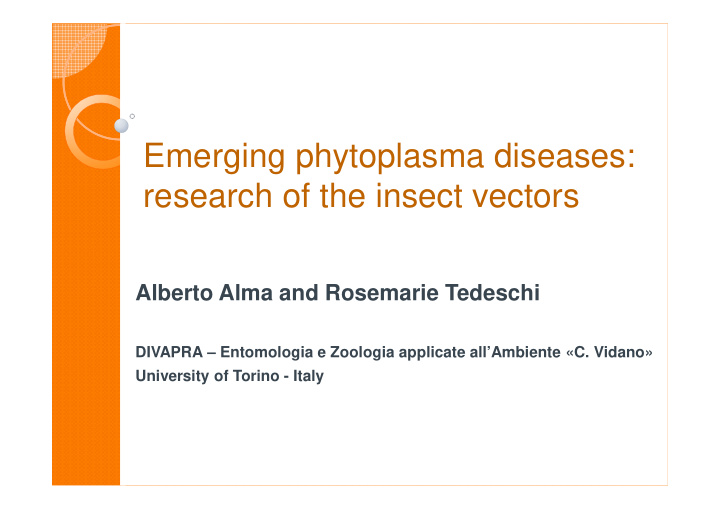



Emerging phytoplasma diseases: research of the insect vectors Alberto Alma and Rosemarie Tedeschi DIVAPRA – Entomologia e Zoologia applicate all’Ambiente «C. Vidano» University of Torino - Italy
In the last years: � Discovery of new phytoplasma diseases � Outbreaks of already known phytoplasma diseases � Europe � Mediterranean Basin and Middle East Impact on EU Countries
Europe � ‘ Candidatus Phytoplasma pini’ (16SrXXI, subgroup A) � Poland, Lithuania, Germany, Spain � Vectors: unknown Valiunas et al ., 2010 Kamìnska et al., 2011 Kamìnska & Berniak, 2011
Europe � Maize redness – Stolbur phytoplasma (16SrXII-A) � Serbia, Bulgaria, Romania, Hungary, Italy � Vectors: Reptalus panzeri Jovi ć , 2010
Mediterranean Basin and Middle East � ‘ Candidatus Phytoplasma phoenicium’ (16SrIX) � Lebanon, Iran � Vectors: unknown
The insect vectors New phytoplasma Unknown diseases Known New outbreaks Possible new vectors
Knowledge of the insect vectors Well timed and efficient control strategies
How to optimize the search of the vectors � Choise of the best sampling method/s � Do not restrict the search only to the crop of interest, but extend it also to the surrounding weeds and shrubs
The Malaise traps
The Malaise traps � Very good when nothing is know in a certain area � High number of insects belonging to different species ‼ No direct association with the crop or the wild vegetation ‼ No alive specimens
The sticky traps � A good support to the Malaise traps for a preliminary screening � Very good to study the population dynamics of a selected group of possible vectors ‼ No direct association with the crop or the wild vegetation ‼ No alive specimens
The beating tray
The sweep net
The beating tray and the sweep net � Very cheap � Allow to investigate plant species selectively Host plant association � Allow to collect alive insects Molecular analyses, laboratory rearings, transmission trials
The vacuum insect collector (D-VAC) � Very useful to sample dense vegetation or the soil surface � Collection of alive insects
Handling of the collected insects � If molecular analyses, laboratory rearings, transmission trials are required Good practices to be followed � Place collected insects in vials containing a leaf or a twig � Use a cool box for transfers � Preserve the samples in pure ethanol or at -20° C
The identification of collected insects Order Hemiptera (Feeding using piercing and sucking mouth parts) Sternorrhyncha Heteroptera (whiteflies, scale insects, (True bugs) aphids, psyllids) Auchenorrhyncha Leafhoppers and planthoppers, spittlebugs etc
The identification of collected insects � Use morphological tools following dichotomous keys. Good expertise is required Appropriate grounding of the technicians
The identification of collected insects The dissection
The identification of collected insects In the case of criptic species Molecular tools for species discrimination They are very useful also for females and young stages
The identification of collected insects Reptalus spp. R. q. R. c. R. p. R. m. M COI-PCR + Alu I R.q.= R. quinquecostatus R.c.= R. cuspidatus R.p.= R. panzeri R.m.= R. melanochaetus ; 600bp 300bp Bertin et al., 2010. Bulletin 100bp of Entomological Research R. p. R. q. R. c. R. m. R. c. R. p. M M 900bp 400bp 1600bp 200bp 1000bp Taq I ITS2- PCR �
The identification of collected insects H. obsoletus H. luteipes H. scotti M Hyalesthes spp. 600bp Bertin et al., 2010. Annals of 300bp Applied Biology COI-PCR + Alu I H. s. H. o. M H. s. H. l. H. o. M 800bp 1600bp 200bp 500bp Taq I ITS2-PCR �
The identification of collected insects Cacopsylla spp. C. melanoneura C. affinis � MEL_fw/MEL_rev DUPLEX-PCR � AFF_fw/AFF_rev Mitochondrial Control Region (CR)-PCR Tedeschi & Nardi, 2010. Bulletin of Entomological Research.
Molecular analyses to ascertain the presence of phytoplasmas in the insects � Preliminary screening to assess the presence of phytoplasmas Positive insect ≠ ≠ ≠ ≠ vector
Transmission trials They are the only prove of vector ability Healthy plants Healthy plants Infected plants Acquisition access Latent period (LP) Inoculation access period (AAP) period (AAP) Plants tested for phytoplasma presence by molecular tools
Transmission trials � Very laborious procedure that requires big ammounts of healty and infected insects and healthy plants � Sometimes we do not know the host plants Transmission trials to an artificial feeding medium
Transmission trials to an artificial feeding medium Feeding solution covered by parafilm Cotton for air source Breeding chamber
Recommend
More recommend